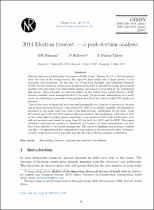JavaScript is disabled for your browser. Some features of this site may not work without it.
- ResearchSpace
- →
- Research Publications/Outputs
- →
- Journal Articles
- →
- View Item
| dc.contributor.author |
Ittmann, HW

|
|
| dc.contributor.author |
Holloway, Jennifer P

|
|
| dc.contributor.author |
Dudeni-Tlhone, Nontembeko

|
|
| dc.date.accessioned | 2017-09-13T10:45:07Z | |
| dc.date.available | 2017-09-13T10:45:07Z | |
| dc.date.issued | 2017-06 | |
| dc.identifier.citation | Ittmann, H.W., Holloway, J.P., and Dudeni-Tlhone, N. 2017. 2014 Election forecast - a post-election analysis. Orion: Journal of the Operations Research of South Africa, vol. 33(1): 35-55. http://dx.doi.org/10.5784/33-1-567 | en_US |
| dc.identifier.issn | 0259-191X | |
| dc.identifier.uri | http://dx.doi.org/10.5784/33-1-567 | |
| dc.identifier.uri | http://orion.journals.ac.za/pub | |
| dc.identifier.uri | http://hdl.handle.net/10204/9555 | |
| dc.description | Orion: Journal of the Operations Research of South Africa, vol. 33(1): 35-55 | en_US |
| dc.description.abstract | General elections are held every five years in South Africa. During the 12 to 24 hour period after the close of the voting booths, the expected final results are of huge interest to the electorate and politicians. In the past, the Council for Scientific and Industrial Research (CSIR) has developed an election forecasting model in order to provide the media and political analysts with forecasts of the final results during this period of peak interest. In formulating this model, which forecasts the election results as the results from voting districts (VDs) become available, some assumptions had to be made. In particular, assumptions were made about the clustering of previous voting patterns as well as the order in which VD results are released. This election forecasting model had been used successfully for a number of elections in the past and in these previous elections, with around 5% {10% of the results available, the predictions produced by the model were very close to the final outcome, particularly for the ANC, being the largest party. For the 2014 national election, however, the predictions, with close to 50% of the voting district results known (equivalent to an estimated 40% of the total votes), were still not accurate and varied by more than 1% for both the ANC and the EFF. This paper outlines a post-election analysis to determine the reasons for these discrepancies and how they relate directly to the model assumptions. The aim is to highlight how practical realities can affect the assumptions and consequently their impact on the forecasted results. Reference is made to previous election forecasts and the 2014 post-election analysis is presented. | en_US |
| dc.language.iso | en | en_US |
| dc.publisher | Operations Research Society of South Africa (ORSSA) | en_US |
| dc.relation.ispartofseries | Worklist;19384 | |
| dc.subject | Forecasting | en_US |
| dc.subject | Elections | en_US |
| dc.subject | Assumptions | en_US |
| dc.subject | Post-election analysis | en_US |
| dc.title | 2014 Election forecast - a post-election analysis | en_US |
| dc.type | Article | en_US |
| dc.identifier.apacitation | Ittmann, H., Holloway, J. P., & Dudeni-Tlhone, N. (2017). 2014 Election forecast - a post-election analysis. http://hdl.handle.net/10204/9555 | en_ZA |
| dc.identifier.chicagocitation | Ittmann, HW, Jennifer P Holloway, and Nontembeko Dudeni-Tlhone "2014 Election forecast - a post-election analysis." (2017) http://hdl.handle.net/10204/9555 | en_ZA |
| dc.identifier.vancouvercitation | Ittmann H, Holloway JP, Dudeni-Tlhone N. 2014 Election forecast - a post-election analysis. 2017; http://hdl.handle.net/10204/9555. | en_ZA |
| dc.identifier.ris | TY - Article AU - Ittmann, HW AU - Holloway, Jennifer P AU - Dudeni-Tlhone, Nontembeko AB - General elections are held every five years in South Africa. During the 12 to 24 hour period after the close of the voting booths, the expected final results are of huge interest to the electorate and politicians. In the past, the Council for Scientific and Industrial Research (CSIR) has developed an election forecasting model in order to provide the media and political analysts with forecasts of the final results during this period of peak interest. In formulating this model, which forecasts the election results as the results from voting districts (VDs) become available, some assumptions had to be made. In particular, assumptions were made about the clustering of previous voting patterns as well as the order in which VD results are released. This election forecasting model had been used successfully for a number of elections in the past and in these previous elections, with around 5% {10% of the results available, the predictions produced by the model were very close to the final outcome, particularly for the ANC, being the largest party. For the 2014 national election, however, the predictions, with close to 50% of the voting district results known (equivalent to an estimated 40% of the total votes), were still not accurate and varied by more than 1% for both the ANC and the EFF. This paper outlines a post-election analysis to determine the reasons for these discrepancies and how they relate directly to the model assumptions. The aim is to highlight how practical realities can affect the assumptions and consequently their impact on the forecasted results. Reference is made to previous election forecasts and the 2014 post-election analysis is presented. DA - 2017-06 DB - ResearchSpace DO - 10.5784/33-1-567 DP - CSIR KW - Forecasting KW - Elections KW - Assumptions KW - Post-election analysis LK - https://researchspace.csir.co.za PY - 2017 SM - 0259-191X T1 - 2014 Election forecast - a post-election analysis TI - 2014 Election forecast - a post-election analysis UR - http://hdl.handle.net/10204/9555 ER - | en_ZA |






